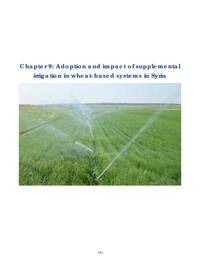Adoption and impact of supplemental irrigation in wheat-based systems in Syria
Published Date
January 15, 2011
Type
Book Chapter

Authors:
Nidal Jouni, Kamel Shideed
Agriculture in Syria depends on a wide base of varied natural resources extending over five agro-ecological zones differing in total precipitation, soil structure, and water resources such as rivers, springs, dams, and groundwater which supplies water for about 851,000 ha (61% of the total irrigated areas). However, precipitation is considered as the main source of the water needed to establish the widespread rainfed system of agriculture, which occupies 70% of the cultivated area in Syria.
Citation:
Amjad Bader, Nidal Jouni, Kamel Shideed. (15/1/2011). Adoption and impact of supplemental irrigation in wheat-based systems in Syria, in "Water Benchmarks of CWANA- Improving water and land productivities in rainfed systems- Number 8". Aleppo, Syrian Arab Republic: University of Aleppo.
Keywords:
benchmark sites
west asia
crop improvement
drought
farming systems
impact assessment
land use
rangelands
water
water-use efficiency
socioeconomics
